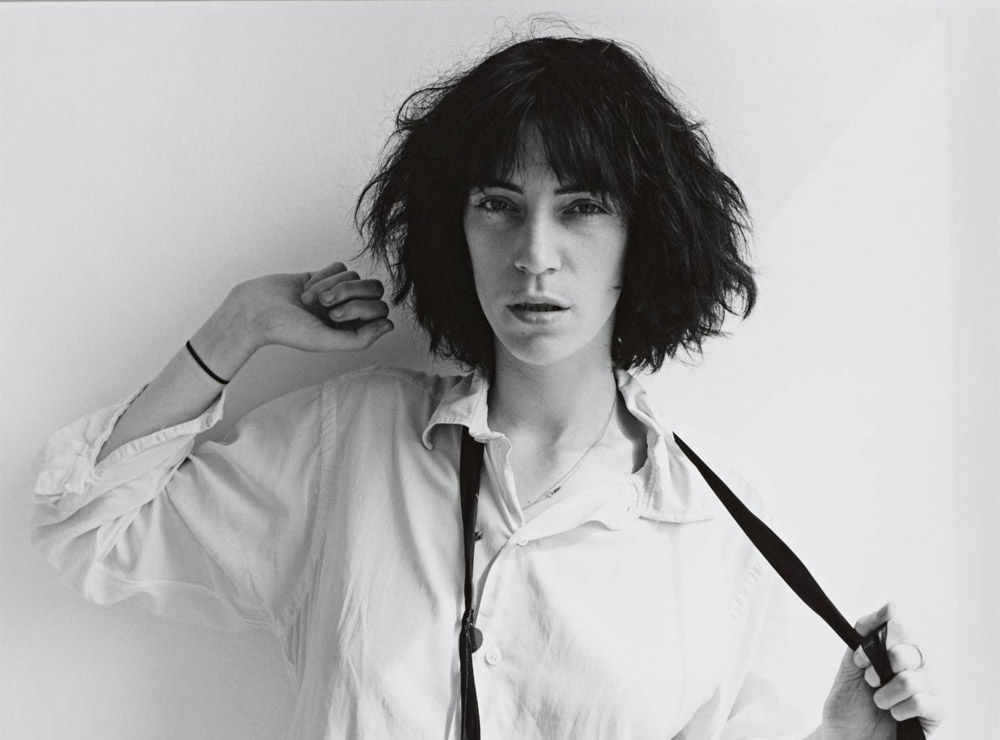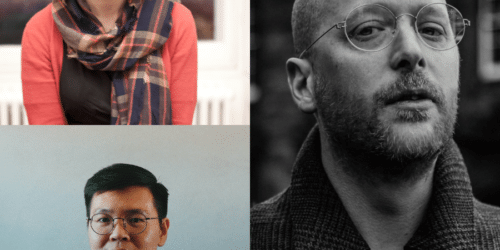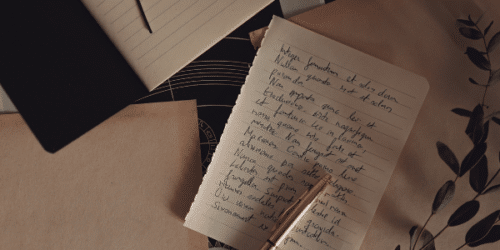
Megan Bradbury’s debut novel, Everyone is Watching, is the ‘unusual, intoxicating and bold’ (the Guardian) story of four great artists – Walt Whitman, Robert Mapplethorpe, Edmund White and Robert Moses – and their erotically charged relationship with New York city. Ahead of her Adnams Spiegeltent event with Eimear McBride and Sarah Hall in May, Megan takes us on a brief tour of her favourite examples of sexuality, identity and desire in photography, film, art and literature.
Images embedded in links, NSFW.
(Top image: Patti Smith by Robert Mapplethorpe)
Nan Goldin
Nan Goldin is American photographer who catalogued her life, friendships and lovers during the 1970s and 80s in an art project called Ballad of Sexual Dependency. These photographs are a frank, open and generous view of her life and friendships. They show the potent energy between the people she knew, a charge – sexual, sometimes violent. In vibrant, over-saturated colour, she shows grief, laughter, pregnancy, death, life, friendship and love – the full spectrum of life.
Photographs From Nan Goldin’s The Ballad of Sexual Dependency (Vogue)
Alvin Baltrop
Alvin Baltrop (1948-2004) was an American photographer, best known for his photographs of Manhattan’s West Side piers, which were the location for gay cruising and art creation in the 1970s and 80s. His photographs are exquisite and show the transient sexual exchanges between men against the backdrop of a crumbling, bankrupt city. He shows the spaces where gay men were both free to be themselves, but also where they faced violence, robbery and assault. The Piers is a fascinating look at New York at a time when the city could be used as a space for sexual and artistic exploration.
Under The Piers: Alvin Baltrop’s Gay New York (AnOther)
 Edmund White (pictured above) is an American author, biographer, memoirist, literary critic and pioneer of the gay novel. His frank and moving description of a gay man’s coming of age in his trilogy that begins with A Boy’s Own Story was a revelation when it was published in 1982. His writing has captivated audiences across the world for over forty years with its interrogation of themes such as shame, desire, identity, love and friendship. No one writes about sex like Edmund White.
Edmund White (pictured above) is an American author, biographer, memoirist, literary critic and pioneer of the gay novel. His frank and moving description of a gay man’s coming of age in his trilogy that begins with A Boy’s Own Story was a revelation when it was published in 1982. His writing has captivated audiences across the world for over forty years with its interrogation of themes such as shame, desire, identity, love and friendship. No one writes about sex like Edmund White.
‘We pulled off our shorts. I opened my arms to Kevin and closed my eyes. He said, “It’s colder than a witch’s tit.” I lay on my side facing him and he slipped in beside me. His breath smelled of milk. His hands and feet were cold. I kept my lower arm scrunched under me, but with the upper one I nervously patted his back. His back and chest and legs were silky and hairless, though I could see a tuft of eiderdown under his arm, which he’d lifted to pat my back in reciprocation. A thin layer of baby fat still formed a pad under his skin. Beneath the fat I could feel the hard, rounded muscles. He reached down under the sheet to touch my penis, and I touched his.’ – A Boy’s Own Story
Hysterical Literature
A video art series by Clayton Cubitt exploring feminism, mind/body dualism and the contrast between culture and sexuality. This series is sublime.
Eimear McBride
In McBride’s books sex is not just sex, it’s also consciousness, language and the communication of inner experience – anguish, joy, hunger, aggression and love. McBride’s writing is passion personified – open, generous, bold and exciting, as all sex should be.
‘Thank him and kiss him and sit on his desk. Open his shirt while he opens the cork. Turn from the pop, then swallow the fizz. Drip bottle mouth to mouth. Kiss. And make what I want, my own normal with him. Belt first. Next his fly. Both now falling back into time where all the past waits outside. It doesn’t matter to me, I say. Then it doesn’t matter tonight, he says. Now take off your clothes and show me yourself, I want to remember every freckle when you’re gone. And I. And bra. Kneels down to my breasts. I. Watch his mouth there. Teeth making twitch running right up to my scalp. How he knows me – and all of me – so much. Kiss. Touch. Already damp his. Slip down where he knelt to. Lick. To put. Oh Fuck, he says, gone so hard in there and now neither us care for she’s away to the back of him. Let her. Let her. His hand in my hair God I love how you do that but lie back on the floor. So do and wait for you on me. In me.’ – The Lesser Bohemians
Shunga
A category of art produced in Japan from 1600 to 1900. ‘Shunga’ translates as ‘spring paintings’. These erotic paintings depict tender and often humorous sex acts in exquisite detail, and were enjoyed by men and women of all classes for nearly 300 years. They are a beautiful celebration of sexual pleasure.
More about Shunga from the British Museum
Louise Bourgeois
Focusing on themes such as domesticity, sexuality and the body, Louise Bourgeois is one of my favourite artists. My favourite piece is Fillette, a sculpture made of latex over plaster, representing, most obviously, a phallus but also a woman’s torso, depending on how you look at it. Bourgeois said, “From a sexual point of view I consider the masculine attributes to be very delicate.” In a photographic portrait of her taken by Robert Mapplethorpe, she can be seen clutching Fillette under her arm. This is partly for jest, given Mapplethorpe’s obsession with male genitalia, but it also shows a link between their work – the desire to see and portray the male body in a new way, as something beautiful and vulnerable, and something to be desired.
Artist profile: Louise Bourgeois (Tate)
 Walt Whitman (1819 – 1892, pictured above) was an American poet, essayist and journalist. His poetry collection Leaves of Grass was criticised for its overt sexuality, and in some areas banned from publication. It combines the philosophy of the self, the transcendental appreciation of nature and a spiritual adoration of bodies and sexual pleasure. His openness to embrace all of life, the light with the dark, the spiritual and the earthly, without judgement is testament to his humanity. His work is both provocative and inspiring.
Walt Whitman (1819 – 1892, pictured above) was an American poet, essayist and journalist. His poetry collection Leaves of Grass was criticised for its overt sexuality, and in some areas banned from publication. It combines the philosophy of the self, the transcendental appreciation of nature and a spiritual adoration of bodies and sexual pleasure. His openness to embrace all of life, the light with the dark, the spiritual and the earthly, without judgement is testament to his humanity. His work is both provocative and inspiring.
‘Twenty-eight young men bathe by the shore,
Twenty-eight young men, and all so friendly,
Twenty-eight years of womanly life, and all so lonesome.
She owns a fine house by the rise of the bank.
She hides handsome and richly drest aft the blinds of the window.
Which of the young men does she like the best?
Ah the homeliest of them is beautiful to her.
Where are you off to, lady? for I see you,
You splash in the water there, yet stay stock still in your room.
Dancing and laughing along the beach came the twenty-ninth bather,
The rest did not see her, but she saw them and loved them.
The beards of the young men glistened with wet, it ran from their long hair,
Little streams passed all over their bodies.
An unseen hand also passed over their bodies,
It descended tremblingly from their temples ribs.
The young men float on their backs, their white bellies swell to the sun…they do not ask who seizes fast to them.
They do not know who puffs and declines with pendant and bending arch,
They do not think whom they souse with spray.’
– Song of Myself
Lucie Blush
Lucie Blush is a feminist pornographer, pornographic actress and originator of the website, We Love Good Sex. Her mantra is “Good porn, erotic videos and eye-candy, from a girl’s point of view”. Her films focus on showing women initiating and exploring their own sexual pleasure without shame, embarrassment or judgement.
Robert Mapplethorpe
Robert Mapplethorpe (1946-1989) was an American photographer, best known for the controversial photographs he took in the 1970s of New York’s gay leather scene. He liked to depict male nudes and male genitalia posed with the precision of classical Greek statues. Most of his photographs are about sex in one form or another, even his still lives of rare and exotic plants presents them as what they are – sexual organs. Mapplethorpe was, according to most sources, incredibly sexy, and his sexual energy is visible in his portraits for they show, as all good portraits should, the spark of connection between the photographer and their subject. As a viewer, you are privy to this connection, and in studies of those who he loved best, Patti Smith, for example, the energy is electrifying.
The Robert Mapplethorpe Foundation
‘Art & Sexuality with Eimear McBride, Sarah Hall and Megan Bradbury’ will take place on 23 May at the Adnams Spiegeltent, Chapelfield Gardens, Norwich. Buy tickets now.
You may also like...
How to improve your poetry: top tips for aspiring poets
Embarking on a new poem can feel like an intimidating task for any poet. In this article, we share our top tips and a creative writing exercise that will help you have fun with your poetry.

18th April 2024
Watch ‘Poetry in the Digital Age’
Join Tse Hao Guang and Sam Riviere as they explore the creative responsibilities within found poetry and the unique relationship between a poet and their work.

12th April 2024
Making Strange: how to write captivating poetry
In this article, poet and NCW Academy tutor Helen Ivory shares her poem ‘The Square of the Clockmaker’, which was chosen to be one of the Poems on the Underground, and how she grabs her readers attention with her poetry by making things strange.

5th January 2024






